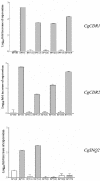Mechanisms of azole resistance in clinical isolates of Candida glabrata collected during a hospital survey of antifungal resistance
- PMID: 15673750
- PMCID: PMC547307
- DOI: 10.1128/AAC.49.2.668-679.2005
Mechanisms of azole resistance in clinical isolates of Candida glabrata collected during a hospital survey of antifungal resistance
Abstract
The increasing use of azole antifungals for the treatment of mucosal and systemic Candida glabrata infections has resulted in the selection and/or emergence of resistant strains. The main mechanisms of azole resistance include alterations in the C. glabrata ERG11 gene (CgERG11), which encodes the azole target enzyme, and upregulation of the CgCDR1 and CgCDR2 genes, which encode efflux pumps. In the present study, we evaluated these molecular mechanisms in 29 unmatched clinical isolates of C. glabrata, of which 20 isolates were resistant and 9 were susceptible dose dependent (S-DD) to fluconazole. These isolates were recovered from separate patients during a 3-year hospital survey for antifungal resistance. Four of the 20 fluconazole-resistant isolates were analyzed together with matched susceptible isolates previously taken from the same patients. Twenty other azole-susceptible clinical C. glabrata isolates were included as controls. MIC data for all the fluconazole-resistant isolates revealed extensive cross-resistance to the other azoles tested, i.e., itraconazole, ketoconazole, and voriconazole. Quantitative real-time PCR analyses showed that CgCDR1 and CgCDR2, alone or in combination, were upregulated at high levels in all but two fluconazole-resistant isolates and, to a lesser extent, in the fluconazole-S-DD isolates. In addition, slight increases in the relative level of expression of CgSNQ2 (which encodes an ATP-binding cassette [ABC] transporter and which has not yet been shown to be associated with azole resistance) were seen in some of the 29 isolates studied. Interestingly, the two fluconazole-resistant isolates expressing normal levels of CgCDR1 and CgCDR2 exhibited increased levels of expression of CgSNQ2. Conversely, sequencing of CgERG11 and analysis of its expression showed no mutation or upregulation in any C. glabrata isolate, suggesting that CgERG11 is not involved in azole resistance. When the isolates were grown in the presence of fluconazole, the profiles of expression of all genes, including CgERG11, were not changed or were only minimally changed in the resistant isolates, whereas marked increases in the levels of gene expression, particularly for CgCDR1 and CgCDR2, were observed in either the fluconazole-susceptible or the fluconazole-S-DD isolates. Finally, known ABC transporter inhibitors, such as FK506, were able to reverse the azole resistance of all the isolates. Together, these results provide evidence that the upregulation of the CgCDR1-, CgCDR2-, and CgSNQ2-encoded efflux pumps might explain the azole resistance in our set of isolates.
Figures



Similar articles
-
Expression Patterns of ABC Transporter Genes in Fluconazole-Resistant Candida glabrata.Mycopathologia. 2017 Apr;182(3-4):273-284. doi: 10.1007/s11046-016-0074-8. Epub 2016 Oct 15. Mycopathologia. 2017. PMID: 27744635
-
The ATP binding cassette transporter gene CgCDR1 from Candida glabrata is involved in the resistance of clinical isolates to azole antifungal agents.Antimicrob Agents Chemother. 1999 Nov;43(11):2753-65. doi: 10.1128/AAC.43.11.2753. Antimicrob Agents Chemother. 1999. PMID: 10543759 Free PMC article.
-
Role of ATP-binding-cassette transporter genes in high-frequency acquisition of resistance to azole antifungals in Candida glabrata.Antimicrob Agents Chemother. 2001 Apr;45(4):1174-83. doi: 10.1128/AAC.45.4.1174-1183.2001. Antimicrob Agents Chemother. 2001. PMID: 11257032 Free PMC article.
-
Resistance in human pathogenic yeasts and filamentous fungi: prevalence, underlying molecular mechanisms and link to the use of antifungals in humans and the environment.Dan Med J. 2016 Oct;63(10):B5288. Dan Med J. 2016. PMID: 27697142 Review.
-
Antifungal drug resistance in pathogenic fungi.Med Mycol. 1998;36 Suppl 1:119-28. Med Mycol. 1998. PMID: 9988500 Review.
Cited by
-
Antifungal Susceptibility Analysis of Clinical Isolates of Candida parapsilosis in Iran.Iran J Public Health. 2016 Mar;45(3):322-8. Iran J Public Health. 2016. PMID: 27141494 Free PMC article.
-
Facultative sterol uptake in an ergosterol-deficient clinical isolate of Candida glabrata harboring a missense mutation in ERG11 and exhibiting cross-resistance to azoles and amphotericin B.Antimicrob Agents Chemother. 2012 Aug;56(8):4223-32. doi: 10.1128/AAC.06253-11. Epub 2012 May 21. Antimicrob Agents Chemother. 2012. PMID: 22615281 Free PMC article.
-
Clotrimazole Drug Resistance in Candida glabrata Clinical Isolates Correlates with Increased Expression of the Drug:H(+) Antiporters CgAqr1, CgTpo1_1, CgTpo3, and CgQdr2.Front Microbiol. 2016 Apr 19;7:526. doi: 10.3389/fmicb.2016.00526. eCollection 2016. Front Microbiol. 2016. PMID: 27148215 Free PMC article.
-
Pluronic F-127 Enhances the Antifungal Activity of Fluconazole against Resistant Candida Strains.ACS Infect Dis. 2024 Jan 12;10(1):215-231. doi: 10.1021/acsinfecdis.3c00536. Epub 2023 Dec 18. ACS Infect Dis. 2024. PMID: 38109184 Free PMC article.
-
The Interkingdom Interaction with Staphylococcus Influences the Antifungal Susceptibility of the Cutaneous Fungus Malassezia.J Microbiol Biotechnol. 2023 Feb 28;33(2):180-187. doi: 10.4014/jmb.2210.10039. Epub 2022 Dec 19. J Microbiol Biotechnol. 2023. PMID: 36575858 Free PMC article.
References
-
- Abi-Said, D., E. Anaissie, O. Uzun, I. Raad, H. Pinzcowski, and S. Vartivarian. 1997. The epidemiology of hematogenous candidiasis caused by different Candida species. Clin. Infect. Dis. 24:1122-1128. - PubMed
-
- Baddley, J. W., A. M. Smith, S. A. Moser, and P. G. Pappas. 2001. Trends in frequency and susceptibilities of Candida glabrata bloodstream isolates at a university hospital. Diagn. Microbiol. Infect. Dis. 39:199-201. - PubMed
-
- Barchiesi, F., L. Falconi Di Francesco, D. Arzeni, F. Caselli, D. Gallo, and G. Scalise. 1999. Electrophoretic karyotyping and triazole susceptibility of Candida glabrata clinical isolates. Eur. J. Clin. Microbiol. Infect. Dis. 18:184-187. - PubMed
Publication types
MeSH terms
Substances
LinkOut - more resources
Full Text Sources
Other Literature Sources
Medical

